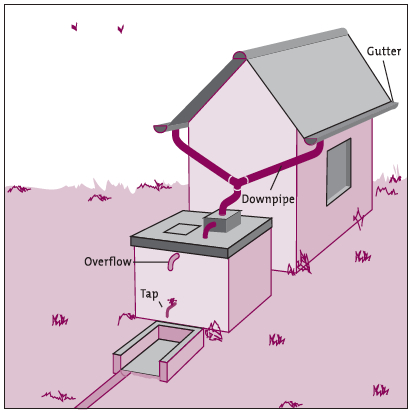മേല്ക്കൂരയില് നിന്നും മഴവെള്ള സംഭരണം
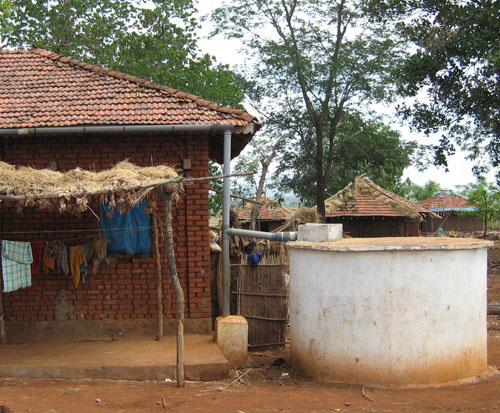
വീടുകളുടേയും മറ്റു കെട്ടിടങ്ങളുടേയും മേല്ക്കൂരയില് പതിക്കുന്ന മഴവെള്ളം ഭൂമിക്കടിയിലോ, അല്ലെങ്കില് ഉപരിതലത്തിനു മുകളിലോ സ്ഥാപിച്ചിരിക്കുന്ന ടാങ്കുകളില് സംഭരിച്ച് പിന്നീട് ജലക്ഷാമം അനുഭവപ്പെടുന്ന സമയത്ത് ഉപയോഗിക്കാനുള്ള സംവിധാനത്തെയാണ് മഴവെള്ള സംഭരണം എന്നതുകൊണ്ടുദ്ദേശിക്കുന്നത്. മേല്ക്കൂരയില് നിന്നും മഴവെള്ളം സംഭരിക്കുന്നതാണ് ഈ സംവിധാനത്തിലെ ഒരു രീതി. മേല്ക്കൂരിയില് പതിക്കുന്ന ശുദ്ധമായ മഴവെള്ളത്തെ പ്ലാസ്റ്റിക്, ഓട് അഥവാ പുല്ലും ഇലയും ഒഴിച്ച് മറ്റെന്തെങ്കിലും കൊണ്ട് തടഞ്ഞു നിര്ത്തി പി.വി.സി., മുള അല്ലെങ്കില് ഇരുമ്പു പൈപ്പുകളിലൂടെ സംഭരണ ടാങ്കിലേക്കെത്തിച്ച് വീടുകള്ക്കാവശ്യമായ ശുദ്ധജലം സംഭരിച്ചു വെക്കാവുന്നതാണ്. മേല്ക്കൂരയില് നിന്നും സംഭരിക്കുന്ന മഴവെള്ളത്തെ താഴെ വച്ചിരിക്കുന്ന തൊട്ടിയിലേക്കോ അല്ലെങ്കില് പരമാവധി 500 ഘന മീറ്റര് വ്യാപ്തമുള്ള ഭൂഗര്ഭ സംഭരണിയിലേക്കോ തിരിച്ചുവിടാവുന്നതാണ്. പല നൂറ്റാണ്ടുകളായി വിവിധ തരം മഴവെള്ള സംഭരണ സംവിധാനങ്ങള് നിലവിലുണ്ടായിരുന്നതായി ചരിത്രം സൂചിപ്പിക്കുന്നു.
ആമുഖം
പലയിടത്തും കുടിവെള്ളത്തിന്റെ ആവശ്യത്തിനായി ഭൂഗര്ഭജലമോ, ഉപരിതല ജലമോ ലഭ്യമല്ലായിരിക്കാം. ഭൂഗര്ഭജലനിരപ്പ് വളരെ ആഴത്തിലായിരുന്നാലും, ഭൂഗര്ഭജലം പല ലവണങ്ങളും കലര്ന്ന് കുടിക്കാന് കൊള്ളാത്ത ഉപ്പുവെള്ളമായിരുന്നാലും ഇതായിരിക്കും സ്ഥിതി. ഉപരിതല ജലവുമ മലീമസമായിരിക്കുമ്പോള് പിന്നെ കുറഞ്ഞ ചെലവില് കൈക്കൊള്ളാവുന്ന ഉചിതമായ രീതി മഴവെള്ള സംഭരണം ആയിരിക്കും.
ഏറ്റവും ശുദ്ധമായ കുടിവെള്ളമാണ് മഴവെള്ളം. അത് നേരിട്ട് മേല്ക്കൂരയില് വന്നു പതിക്കുകയും ചെയ്യുന്നു. മേല്ക്കൂരയില് സ്ഥാപിച്ചിരിക്കുന്ന, ശരിയായ രീതിയില് മൂടി സംരക്ഷിച്ചിരിക്കുന്ന സംഭരണ ടാങ്കുകളിലെ വെള്ളം നല്ല ഗുണമേന്മയുള്ളതാണെന്ന് പഠനങ്ങള് തെളിയിച്ചിട്ടുണ്ട്. വീടുകളിലും, സ്കൂളുകള്, ആശുപത്രികള് പോലുള്ള പൊതുവായ കെട്ടിടങ്ങളിലും മഴവെള്ള സംഭരണം അവലംബിക്കുക വഴി സ്വന്തം ആവശ്യങ്ങള്ക്കുള്ള കുടിവെള്ളം കണ്ടെത്താനാകും, കൂടാതെ വരുമാന മാര്ഗ്ഗങ്ങള്ക്കും സാധ്യതകള് ഉണ്ട്.
വെള്ളമന്വേഷിച്ച് അലഞ്ഞു തിരിയേണ്ട ഗതികേട് ഇതിനാല് ഒഴിവായി കിട്ടും. അതോടെ സ്ത്രീകളും കുട്ടികളും ദൂരെ നിന്നും വെള്ളം നിറച്ച കുടങ്ങളും തലയിലേന്തി നടക്കേണ്ട ആവശ്യം വരില്ല. സംഭരിക്കുന്ന ഓരോ 20 ലിറ്റര് വെള്ളവും, ശുദ്ധജലവുമേന്തി ഒരു കിലോ മീറ്റര് ദൂരം നടക്കേണ്ടതിന്റെ ആവശ്യകത ഇല്ലാതാക്കും. വിപരീത കാലാവസ്ഥയില് വെള്ളവുമേന്തി നടക്കുന്നതിന്റെ ബുദ്ധിമുട്ട് കണക്കിലെടുക്കുമ്പോള് ഈ സംവിധാനത്തിലൂടെ ലഭിക്കുന്ന ചെറിയ ആദായം പോലും വളരെ വിലപ്പെട്ടതാണെന്നു കാണാം. ശ്രീലങ്കയിലും, ആഫ്രിക്കയിലെ ഉഗാണ്ടയിലും സാധാരണയായി വൃക്ഷങ്ങള്ക്കു മുകളില് വാഴയിലയും മറ്റു താല്ക്കാലിക വെള്ളച്ചാലുകളും കൊണ്ടാണ് വെള്ളം സംഭരിക്കുക പതിവ്. വര്ഷപാതം ഏല്ക്കുന്ന ഏതൊരു വീടിന്റെ മുകളിലും, ആ വീട് സ്ഥിതി ചെയ്യുന്നത് മലമുകളിലോ അല്ലെങ്കില് നടുക്കടലില് ഉള്ള ചെറിയ ദ്വീപിലായിരുന്നാലും ഈ സൗകര്യം പ്രയോജനകരമായി ഏര്പ്പെടുത്താവുന്നതാണ്.
വിവിധ സ്രോതസ്സുകളില് നിന്നും വെള്ളം കണ്ടെത്തലാണ് മറ്റൊരു രീതി. ഉപ്പുവെള്ളം പോലും ശുചീകരണവുമായി ബന്ധപ്പെട്ട കാര്യങ്ങള്ക്ക് ഉപയോഗപ്പെടുത്താനാകും. ഗുണമേന്മയുള്ള മഴവെള്ളം ടാങ്കില് സംഭരിക്കുക വഴി പാചകത്തിനും, കുടിവെള്ളത്തിനും അത് ഉപയോഗിക്കുകയുമാകാം.
അനുയോജ്യമായ പരിതസ്ഥിതികള്
മഴവെള്ള സംഭരണം കാര്യക്ഷമമാകണമെങ്കില് ശരാശരി വാര്ഷിക മഴലഭ്യത 100 മുതല് 200 മി.മീ. വരെയെങ്കിലും ഉണ്ടായിരിക്കണം. ലാറ്റിനമേരിക്കയിലെ മിക്ക നാടുകളിലും പെയ്യുന്ന മഴയുടെ തോത് പ്രതിവര്ഷം 500 മി.മീ. വരെയാണ്.
മേല്ക്കൂരയുടെ വിസ്തൃതി കുറവായിരുന്നാല് പോലും ഈ രീതി അനുയോജ്യമായിരിക്കും. ഉദാഹരണത്തിന് (56) മീറ്റര് (അതായത് 30 ചതുര മീറ്റര്) വിസ്തൃതിയുള്ള മേല്്ക്കൂരയോടു കൂടിയ ഒരു വീട്, വാര്ഷിക വര്ഷപാതം 500 മി.മീ. ആണെങ്കില് ഏകദേശം 15,000 ലിറ്റര് വെള്ളമാണ് ആ വീടിന്റെ മേല്ക്കൂരയില് പതിക്കുക. സാധാരണ ഗതിയില് 5 അംഗങ്ങള് വരെയുള്ള ഒരു കുടുംബത്തിന് ഇത്രയും വെള്ളം ധാരാളമാണ്.
| ഗുണങ്ങള് | ദോഷങ്ങള് |
|---|---|
| - ഏതു കാലാവസ്ഥയിലും സാധ്യമാണ് - ശരിയായി പരിപാലിക്കുന്നപക്ഷം മഴവെള്ളം ഗുണമേന്മയുള്ള കുടിവെള്ളത്തിന് അനുയോജ്യമായിരിക്കും. |
- വരള്ച്ച അനുഭവപ്പെടുന്ന കാലം മുഴുവനും സംഭരണ സംവിധാനം ആവശ്യമായിരിക്കും. |
പരിസ്ഥിതി മാറ്റങ്ങള്ക്കനുസൃതമായ നടപടികള്
വരള്ച്ച
വരള്ച്ച കൊണ്ടുണ്ടാകുന്ന പ്രശ്നങ്ങള്: സംഭരിച്ചു വച്ചിരിക്കുന്ന വെള്ളം ഉപയോഗിച്ചു തീരും..
പ്രശ്നങ്ങള്ക്ക് കാരണം: മഴക്കുറവ്; നിലവാരമില്ലാത്ത നിര്മ്മാണം കാരണം ചോര്ന്നൊലിക്കുന്ന ലൈനിംഗുകള്; സംഭരണശേഷി ആവശ്യത്തിനനുയോജ്യമല്ലാതിരിക്കല് - ദീര്ഘകാലം തുടരുന്ന വേനലില് ആവശ്യമായത്ര വെള്ളം സംഭരിക്കാന് പോന്ന ടാങ്കുകള്ക്ക് വേണ്ടി വരുന്ന അധിക ചെലവ്..
To increase resiliency of WASH system: നിര്മ്മിക്കാനും, മൂടി വെക്കാനും എളുപ്പമായ ചെറിയ ടാങ്കുകള് കൂടുതലായി ഉപയോഗിക്കാന് പ്രേരിപ്പിക്കുക, അതേ സമയം അത് കുടുംബങ്ങള്ക്ക് താങ്ങാവുന്ന പരിധിയിലായിരിക്കയും വേണം.; മോശമായ നിര്മ്മാണ രീതികൊണ്ടുണ്ടായേക്കാവുന്ന ചോര്ച്ചയും, കിനിവും കുറയ്ക്കുക, ശരിയായ കോണ്ക്രീറ്റ് മിശ്രിത അനുപാതം അവലംബിക്കുക (വരള്ച്ച കൊണ്ട് സിമന്റിനുണ്ടാകുന്ന കേടുപാടുകളെക്കുറിച്ച് താഴെക്കൊടുത്തിരിക്കുന്നത് വായിക്കുക) ; Make tanks from cheaper lower quality materials and repair more often; Design the outlet of the tank so that there is no dead storage; Ensure the catchment itself is efficient (e.g. gutters); Improve access to micro-finance; Support the capacity of the government or private sector to be able to provide (for payment) a tankering scheme.
സിമന്റ് ടാങ്കുകളില് വരള്ച്ചയുടെ പ്രത്യാഘാതങ്ങള്
വരള്ച്ച കൊണ്ടുണ്ടാകുന്ന പ്രശ്നങ്ങള്: Badly made concrete and cracked linings (e.g. in tanks, dams, waterways, wells, and other structures).
Underlying causes of effects: Less water used for curing; Impure water used for mixing.
To increase resiliency of WASH system: Ensure adequate mixing, ratios, purity of ingredients; Minimize water content in mixture; Ensure adequate curing.
More information on managing drought: Resilient WASH systems in drought-prone areas.
Making cement in regards to drought: Concrete production and drought.
Construction, operations & maintenance
Catchment & storage tanks
The flow of water can be intercepted in different ways. Different catchment types are used, such as roof catchment, paved surface catchment, surface catchment and riverbed catchment. The cheapest storage of all is to use the ground as storage area, a technique called groundwater recharge. It is accomplished by letting rainwater infiltrate in the ground. The recharge will locally lead to a higher water table, from which water can be pumped up when needed. Whether the infiltrated water raises the water table in a local area or is spread across a wider area depends on soil conditions.
If using storage tanks, structures made with ferrocement or brick-cement are the best and cheapest options, and they can be made locally. When a water tank is below ground, it is called a cistern. Among the different storage types are the underground tank, ferro-cement tank, plastic-lined tank, etc. The size of the tank is a compromise between cost, the volume of water used, the length of the dry season, etc. It is advisable to first construct a small tank before attempting a large one. Storage tanks can additionally be filled up using pumps. Several pump systems can be used to lift the water from underground tanks, for example with a rope pump or with a deep well pump, which can elevate water up to a height of 30 m.
വെള്ളം ശുദ്ധമായി സൂക്ഷിക്കല്
Roof rainwater is usually of good quality and does not require treatment before consumption. If the house has a chimney, however, it is possible that the water becomes smoky. High chimneys are therefore preferred. Water is collected through roof gutters made of PVC, bamboo, etc. and stored. The most important thing to ensure water quality is a good lid, keeping out light and insects, and a filter, keeping out all kinds of dirt. A concrete lid protects the tank from pollution. Small fishes can be kept in the tank to keep it free from insects.
A foul-flush device or detachable down-pipe can be fitted that allows the first 20 litres of runoff from a storm to be diverted from the storage tanks. This is because runoff is contaminated with dust, leaves, insects and bird droppings. To prevent the use of dirty water, the runoff is then led through a small filter of gravel, sand and charcoal before entering the storage tank, or a filter is placed between the catchment structure and the storage tank. Where there is no foul-flush device, the user or caretaker has to divert away the first 20 litres at the start of every rainstorm.
EMAS ഫില്ട്ടറേഷന് സിസ്റ്റം
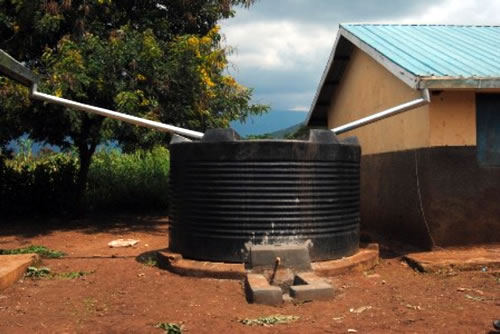
The EMAS system for rainfall collection uses various EMAS technologies as well as simple tools to convert rainwater into usable drinking water. If roof rainwater is being used, it is collected through a regular gutter. To filter the water, at the bottom of the gutter, a pitcher or ferrocement tank is placed, with an outlet pipe. A synthetic cloth bag is attached to the rim of the pitcher using an iron ring or wire, which fits around the edge. The bag should be cleaned every 3 months.
As water begins to collect, to avoid too much garbage collecting here, first some amount of water is deflected, along with most of the garbage. Hereafter, water can be directly sent to an EMAS Cistern. It is advisable for multiple cisterns to be available for storage, depending on the size of the roof. Connect one cistern at a time to the outlet pipe. From here water can be pumped and distributed using a regular EMAS pump. The pump can also be connected to faucets and tanks around the house.
അറ്റകുറ്റപ്പണികള്
The system should be also checked and cleaned after every dry period of more than one month. The outsides of metal tanks may need to be painted about once a year. Leaks have to be repaired throughout the year, especially from leaking tanks and taps, as they present health risks. Chlorination of the water may be necessary.
Removal of debris and overhanging vegetation from gutters and the roof is important to prevent the gutter being clogged. Tank maintenance consists of physical inspection and repairing cracks with cement. Several studies have shown that water from well maintained and covered rooftop tanks generally meets drinking water quality standards if maintained rightfully.
Basic water quality testing is recommended during the first year, with further testing when water quality is in doubt. A low cost water test is the ‘HACH’ test, about US$1 per test. If contamination is suspected or when water quality needs to be guaranteed, the water can be treated in several ways.
കൂട്ടായ്മയിലൂടെ ജലസംഭരണം
Operation and maintenance (O&M) of shared roofs have more challenges. Rooftop-harvesting systems at schools, for instance, may lose water from taps left dripping. Padlocks are often needed to ensure careful control over the water supply. Ideally, one person should be responsible for overseeing the regular cleaning and occasional repair of the system, control of water use, etc. One option is to sell the water, which ensures income for O&M and for organizing water use. Where households have installed a communal system (e.g. where several roofs are connected to one tank), the users may want to establish a water committee to manage O&M activities. The activities may include collecting fees, and controlling the caretaker’s work and the water used by each family. External agents can play a role in the following O&M areas:
— monitoring the condition of the system and the water quality;
— providing access to credit facilities for buying or replacing a system;
— training users/caretakers for management and O&M;
— training local craftsmen to carry out larger repairs.
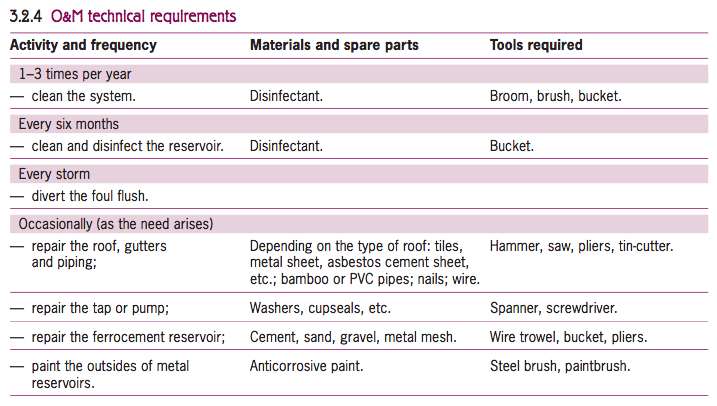
പ്രശ്ന സാധ്യതകള്
- corrosion of metal roofs, gutters, etc.;
- the foul-flush diverter fails because maintenance was neglected;
- taps leak at the reservoir and there are problems with the handpumps;
- contamination of uncovered tanks, especially where water is abstracted with a rope and bucket;
- unprotected tanks may provide a breeding place for mosquitoes, which may increase the danger of vector-borne disease;
- system may not fulfill drinking-water needs, during certain periods of the year, making it necessary to develop other sources or to go back to traditional sources temporarily;
- financial investment needed is not affordable - households or communities cannot afford to construct a suitable tank and adequate roofing.
ചെലവുകള്
Comparison of costs
- Brick cement tank of 6 m3: 3 bags of cement, 300 bricks, 3 kg of wire US$ 40
- Brick cement tank of 1 m3: 1 bag of cement, 100 bricks, 1 kg of wire US$ 20
- Plastic-lined tank of 5 m3: US$ 50
- Sub-surface ferro-cement tank of 60 m3: US$ 1,900
The bigger the volume of the storage tank, the lower the material demand (and thus costs) for construction per m3 of tank volume.
In Southern Africa, US$ 320 for a system with 11 m of galvanized iron gutter; a 1.3 m3 galvanized iron tank; downpiping; tap and filters; cost does not include transportation. Where roofs are not suitable for water harvesting, the cost of roof improvement and gutters will have to be added to the cost of a tank. Such costs varied from US$ 4 per m2 (Kenya, subsidized) to US$ 12 per m2. 1
പ്രായോഗിക അനുഭവങ്ങള്
- Rainwater harvesting is a technology which is extremely flexible and adaptable to a wide variety of settings, it is used in the richest and poorest societies on the planet, and in the wettest and driest regions of the world.
- In Ocara, Brazil, rainwater tanks have been constructed of concrete blocks.
- A low-cost option is the brick cement tank, used in for example Nicaragua and Ghana.
Akvo RSR പ്രൊജക്ടുകള്
The following projects utilize rooftop rainwater harvesting.
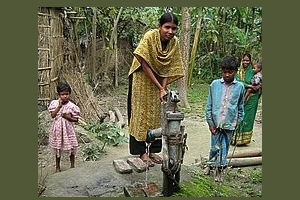 WaSH program in Rural Bangladesh |
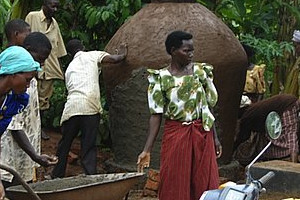 Raising awareness on rainwater harvesting |
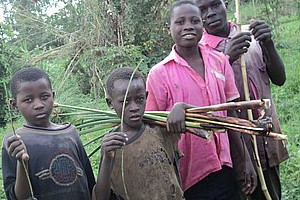 Wetland Management & Water Harvesting |
 Raising awareness on rainwater harvesting |
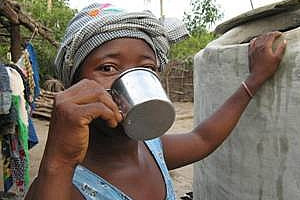 Rainwater harvesting in Guinee Bissau | ||
സഹായ ഗ്രന്ധങ്ങളും, വീഡിയോകളും, ലിങ്കുകളും
സഹായ ഗ്രന്ധങ്ങള്
- Download the book "Roofwater Harvesting: A Handbook for Practitioners" from the IRC website.
- Booklet Smart Water Harvesting Solutions
വീഡിയോകള്
by BSP-Nepal |
Harvesting rooftop rainwater |
Pushpam Singh |
Bangalore rural district |
പുറത്തേക്കുള്ള കണ്ണികള്
- Rainwater Harvesting Implementation Network (RAIN)
- Rainwater Harvesting information on Practical Action
- Indian website on rainwater harvesting
- Wikipedia article on rainwater harvesting
- Rainwater Harvesting info on the DTU unit of University of Warwick
- Rainwater Partnership
- Rainwater Toolkit
- Akvo solution of the week 5
അവലംബം
- ↑ 1.0 1.1 Brikke, François, and Bredero, Maarten. Linking technology choice with operation and maintenance in the context of community water supply and sanitation: A reference document for planners and project staff. World Health Organization and IRC Water and Sanitation Centre. Geneva, Switzerland 2003.
കൃതജ്ഞത
- Brikke, François, and Bredero, Maarten. Linking technology choice with operation and maintenance in the context of community water supply and sanitation: A reference document for planners and project staff or (alternative link). World Health Organization and IRC Water and Sanitation Centre. Geneva, Switzerland 2003.
- CARE Nederland, Desk Study Resilient WASH systems in drought-prone areas. October 2010.
